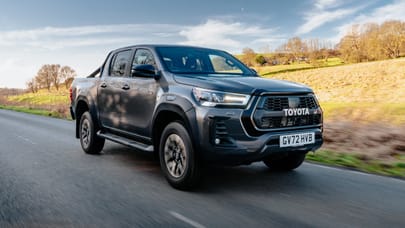
Toyota Hilux review
Driving
What is it like to drive?
Hate to puncture the suspense here, but the Hilux drives like A Pick-Up Truck. Like everyone who builds trucks of this shape and size, Toyota talks a good game about SUV-ifying the experience, but the combination of leaf springs, fat tyres, a tall ride height and the weight distribution of a lonely see-saw mean all of these things share some pretty common traits. You’re unlikely to mistake the road manners for a Range Rover’s.
While you sense the ride’s more settled down at the rear than pick-ups of yore, and body roll has been contained for such a tall beast, you’re still jostled and rattled about on your Brunellian ladder frame and 19th Century frontiersman suspension. The twirly, sluggish steering is slow and remote, devoid of any feel, and the brakes tend to be grabby. Roundabouts are less than fun.
Keep going...
Toyota stubbornly stuck with carthorse springs – albeit with new bushes – to stay true to the Hilux’s roots. While admitting they give away ride comfort and refinement, Toyota insists you’ll forgive that when they soak up years of maintenance-free punishment that’d cripple coil springs. If this truck is your business workhorse, time off the road equals money out of your pocket, and for that hardiness you’ll likely accept a bit of roughshod road performance.
The biggest compliment we can pay the automatic gearbox is that you’ll barely give it a moment’s thought, as it guesses the right ratio at the right time. And teamed with the 201bhp, 369lb ft four-cylinder turbodiesel engine – it’s not as clattery or strained as you might expect, even under full throttle – you’ll make respectable progress without blowing out your eardrums.
And what about this hybrid?
Ah yes. It’s the 2.8-litre diesel with a permanent magnet synchronous unit bolted on – literally, Toyota’s found a way to slot it in without meddling with the regular layout at all.
Toyota points to a range of benefits including improved controllability, on account of the idle speed falling from 720 to 620rpm. But the main one is that regen braking tops up a tiny battery (4.3Ah – it only weighs a few kilos) to help the engine out, mostly at low speeds when it’s at its least efficient. Seven per cent improvement in consumption is the claim, and as a result the hybrid is the thirstiest Hilux of the lot.
Say what now?
Yep. As it can only be paired with the 2.8 auto, it returns an official 27.9mpg and 265g/km to the manual’s 29.7mpg and 250g/km. So it’s better than auto-only, in other words. That’s the lab test though: in a day off-roading around deepest, dustiest Turkey, we managed… about 18mpg in both the hybrid and GR Sport II, with the latter doing slightly better. Ouch. If you’re planning on being more sympathetic with your Hilux, fear not: we’ve seen returns on par with the official numbers in mixed road driving.
For what it’s worth, the automatic 2.4 splits the difference at 28.9mpg.
What’s it like in practice?
You’ll barely notice the difference, honestly. It’s like insulating your loft: it doesn’t change how warm you are, it just lowers your heating bills. There’s a bit of loose travel at the top end of the brake pedal, but aside from killing the engine for a bit longer at the lights, it’s imperceptible.
What will catch your eye are the toys: for the first time on the Hilux the hybrid introduces a Multi-Terrain Select system with six settings: Sand, Mud, Rock, Dirt, Deep Snow, and an Auto mode to pick the best one. This in addition to four-wheel drive, a low-range ‘box and Downhill Assist Control for gracefully navigating steep drops.
There’s an automatic limited-slip diff which works in two-wheel drive mode and means you can get surprisingly far into the wild before engaging full-time four-wheel drive. Ground clearance is a lofty 310mm and it’ll ford streams up to 700mm deep.
And the GR Sport?
Like Ford's Ranger Raptor, this one’s tuned for the road instead of the wilderness, where there’ll be actual people to judge your 4x4 fashion statement. If that sounds harsh, it is – the GR Sport is very capable off the beaten track, but it rides firmer than the hybrid so doesn’t cushion your spine/posterior nearly as well. Still, deactivate the traction control in two-wheel drive and it’s a real hoot as the limited-slip differential scrabbles to bail you out with every turn of the wheel.
It also doesn’t get the terrain modes or hill descent control like the hybrid, so it’ll probably get stuck sooner. All you have to play with are Eco and Power buttons that alter the engine map, throttle and gearbox… you’ll press ‘em once and then forget them forever.
All in, it’s a bit of a miss: it’s slower than a Raptor, less engaging, not as good-looking and not finished as well inside. Though it does claim victory in the towing and payload stakes.
Crumbs, I’d forgotten about towing. What’s the scoop?
The Hilux’s stats are right on the money. It’ll tow 3,500kg braked, the payload is just over a tonne regardless of which model you choose, and the load bay itself measures 1,525mm long by 1,540mm wide.
Variants We Have Tested










